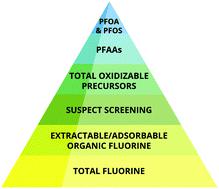当前位置:
X-MOL 学术
›
Environ. Sci.: Processes Impacts
›
论文详情
Our official English website, www.x-mol.net, welcomes your feedback! (Note: you will need to create a separate account there.)
Strategies for grouping per- and polyfluoroalkyl substances (PFAS) to protect human and environmental health.
Environmental Science: Processes & Impacts ( IF 5.5 ) Pub Date : 2020-06-04 , DOI: 10.1039/d0em00147c Ian T Cousins 1 , Jamie C DeWitt , Juliane Glüge , Gretta Goldenman , Dorte Herzke , Rainer Lohmann , Mark Miller , Carla A Ng , Martin Scheringer , Lena Vierke , Zhanyun Wang
Environmental Science: Processes & Impacts ( IF 5.5 ) Pub Date : 2020-06-04 , DOI: 10.1039/d0em00147c Ian T Cousins 1 , Jamie C DeWitt , Juliane Glüge , Gretta Goldenman , Dorte Herzke , Rainer Lohmann , Mark Miller , Carla A Ng , Martin Scheringer , Lena Vierke , Zhanyun Wang
Affiliation

|
Grouping strategies are needed for per- and polyfluoroalkyl substances (PFAS), in part, because it would be time and resource intensive to test and evaluate the more than 4700 PFAS on the global market on a chemical-by-chemical basis. In this paper we review various grouping strategies that could be used to inform actions on these chemicals and outline the motivations, advantages and disadvantages for each. Grouping strategies are subdivided into (1) those based on the intrinsic properties of the PFAS (e.g. persistence, bioaccumulation potential, toxicity, mobility, molecular size) and (2) those that inform risk assessment through estimation of cumulative exposure and/or effects. The most precautionary grouping approach of those reviewed within this article suggests phasing out PFAS based on their high persistence alone (the so-called “P-sufficient” approach). The least precautionary grouping approach reviewed advocates only grouping PFAS for risk assessment that have the same toxicological effects, modes and mechanisms of action, and elimination kinetics, which would need to be well documented across different PFAS. It is recognised that, given jurisdictional differences in chemical assessment philosophies and methodologies, no one strategy will be generally acceptable. The guiding question we apply to the reviewed grouping strategies is: grouping for what purpose? The motivation behind the grouping (e.g. determining use in products vs. setting guideline levels for contaminated environments) may lead to different grouping decisions. This assessment provides the necessary context for grouping strategies such that they can be adopted as they are, or built on further, to protect human and environmental health from potential PFAS-related effects.
中文翻译:

将全氟烷基物质和多氟烷基物质(PFAS)分组以保护人类和环境健康的策略。
全氟烷基物质和多氟烷基物质(PFAS)需要分组策略,部分原因是在逐个化学基础上测试和评估全球市场上的4700多种PFAS需要大量时间和资源。在本文中,我们回顾了各种可用于指导对这些化学物质采取行动的分组策略,并概述了每种化学物质的动机,优点和缺点。根据PFAS的内在属性,将分组策略细分为(1)个(例如持久性,生物蓄积性,毒性,迁移率,分子大小)和(2)通过估计累积暴露量和/或影响来告知风险评估的因子。在本文中所回顾的那些中,最预防性的分组方法建议仅基于其持久性高而逐步淘汰PFAS(即所谓的“ P充足”方法)。审查的最少预防性分组方法主张仅将具有相同毒理学作用,作用方式和作用机理以及消除动力学的PFAS进行风险评估,这需要在不同的PFAS中进行充分记录。公认的是,由于化学评估理念和方法在管辖范围上存在差异,因此没有一种策略是可以普遍接受的。我们适用于已审查的分组策略的指导性问题是:出于什么目的分组?分组背后的动机(例如,确定产品的用途与为受污染的环境设置准则水平)可能会导致不同的分组决策。该评估为分组策略提供了必要的背景,以便可以按原样采用或进一步采用这些策略,以保护人类和环境健康免受与PFAS相关的潜在影响。
更新日期:2020-07-22
中文翻译:

将全氟烷基物质和多氟烷基物质(PFAS)分组以保护人类和环境健康的策略。
全氟烷基物质和多氟烷基物质(PFAS)需要分组策略,部分原因是在逐个化学基础上测试和评估全球市场上的4700多种PFAS需要大量时间和资源。在本文中,我们回顾了各种可用于指导对这些化学物质采取行动的分组策略,并概述了每种化学物质的动机,优点和缺点。根据PFAS的内在属性,将分组策略细分为(1)个(例如持久性,生物蓄积性,毒性,迁移率,分子大小)和(2)通过估计累积暴露量和/或影响来告知风险评估的因子。在本文中所回顾的那些中,最预防性的分组方法建议仅基于其持久性高而逐步淘汰PFAS(即所谓的“ P充足”方法)。审查的最少预防性分组方法主张仅将具有相同毒理学作用,作用方式和作用机理以及消除动力学的PFAS进行风险评估,这需要在不同的PFAS中进行充分记录。公认的是,由于化学评估理念和方法在管辖范围上存在差异,因此没有一种策略是可以普遍接受的。我们适用于已审查的分组策略的指导性问题是:出于什么目的分组?分组背后的动机(例如,确定产品的用途与为受污染的环境设置准则水平)可能会导致不同的分组决策。该评估为分组策略提供了必要的背景,以便可以按原样采用或进一步采用这些策略,以保护人类和环境健康免受与PFAS相关的潜在影响。



























 京公网安备 11010802027423号
京公网安备 11010802027423号